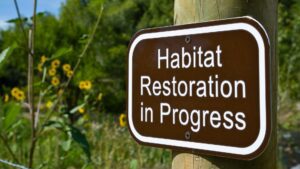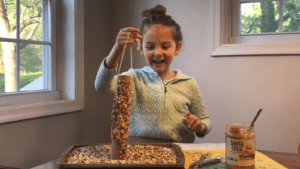
Pre-Built Lesson: Earth Day
We love celebrating the Earth – our home – and are so excited to share this Earth Day lesson plan! Designed for elementary schoolers, you’ll explore the different types and requirements of a habitat, read about the amazing Jane Goodall, and create a tasty treat for your feathered friends.
Resources in This Lesson
Resource 1
Have fun learning about different types of habitats and the ways humans and animals adapt them to meet their needs!
Rosie Explores Habitats
https://handsonstem.rosieriveters.com/resources/habitats/
Resource 2
In this episode of Rosie Reads, we’re reading about primatologist, conservationist, and UN Messenger of Peace Jane Goodall!
Rosie Reads I am Jane Goodall
https://handsonstem.rosieriveters.com/resources/rosie-reads-i-am-jane-goodall/
Resource 3
Want to adapt your habitat so it’s more welcoming to winged wildlife? Make this bird feeder from Rosie Makes!
Rosie Makes Bird Feeders
https://handsonstem.rosieriveters.com/resources/bird-feeders/
Resource 4
Continue learning and exploring with some of these tried and tested Rosie Recommends activities from other STEM educational resources.
Rosie Recommends Earth Day Activities!
https://handsonstem.rosieriveters.com/resources/earth_day_activities/

Join Rosie Girl Veronica as she talks about different types of habitats and how humans and animals adapt them to meet their needs!
A successful animal habitat provides four things: food, water, shelter, and protection. And there are five different types of habitats on earth (based on biomes):
- Aquatic
- Grassland
- Tundra
- Desert
- Forest
Want to evaluate habitats at home or in your classroom? Watch the video for an overview and follow the instructions below!
Watch The Video
https://youtu.be/FwfcOhN1ACg
Step-By-Step Instructions
Step 1
Get outside! Identify an animal habitat around you. Remember the four elements that a successful habitat provides: food, water, shelter, and protection.
Step 2
Identify what type of habitat you found. What animal lives there? How has it adapted the habitat to meet its needs? Conversely, how might the animal itself adapt to live successfully in the habitat?
Step 3
What type of habitat is it: aquatic, grassland, tundra, desert, or forest? To read more about these types of habitats, visit ThoughtCo!
Step 4
Think about what habitat you live in! How does your habitat compare to others? How have you adapted your habitat to meet your need for food, protection, water, etc.?

Rosie Reads I am Jane Goodall
Jane Goodall was born in London in 1934. And, as the 2016 book I am Jane Goodall by Brad Meltzer charmingly demonstrates, she had an early love for animals. She left school at the age of 18 and began observing chimpanzees in Gombe before obtaining any formal scientific training. Yet the work she did there is considered to be amongst “the greatest achievements of twentieth-century scholarship.” Today she is an international advocate for conservation and a UN Messenger of Peace.
When you’re finished reading I am Jane Goodall, ask kids these comprehension questions:
- How did Jane Goodall become a ground-breaking researcher in Gambia? What other jobs did she have first?
- What were some of Goodall’s amazing discoveries about chimpanzees?
Interested kids can also join Roots & Shoots, Jane Goodall’s network for young people seeking to affect positive change in their communities; find out more at www.rootsandshoots.org!
For our Rosie Reads activity, we’re talking about passion, careers, and perseverance! Jane Goodall’s love for animals began when she was a child; ask kids what they are passionate about right now, and if that has changed over the years. It’s fun if they know about things they loved as toddlers – have kids prepare for the conversation in advance by taking a questionnaire home. Or, if you’re doing it with your own kids, remind them! Take some time online and research how these passions might lead to future jobs and careers like they did for Goodall.
Be sure to go back to the book too and reconsider Jane’s path to becoming a primatologist. It took time, persistence, and several other jobs to get there. Emphasize this, and ask kids to imagine the paths they could take to get to the careers you discussed. What challenges and pitfalls might they face along the way?
Watch The Video
https://youtu.be/1a5-MrvrsVI
Items Available to Purchase
-
Rosie Reads About Real Women in STEM, set 2
https://www.rosieriveters.com/shop#!/Rosie-Reads-about-Real-Women-in-STEM-II/p/257390117/category=53184730
Bird feeders are one of the many ways that humans have adapted their habitats to make them more hospitable to wildlife. Habitats must support four basic needs: food, water, shelter and space. In this Rosie Makes, we are working to attract more animals to our habitat by providing one of those basic needs – food!
Ready to make this project at home or in your classroom? Watch the video for an overview, gather the materials listed at the right, and follow the instructions below!
Watch The Video
https://www.youtube.com/watch?v=aW49NFB7_q0
Required Materials
- craft roll
- string
- bird seed
- cookie sheet or tray
- hole punch
- peanut butter
Step-By-Step Instructions
Step 1
Create a hole on either side of your craft roll (we used a hole punch to make this process easier).
Step 2
Thread a string through the hole in the craft roll and tie the two ends together to make a handle.
Step 3
Spread peanut butter all over the surface of the craft roll.
Step 4
Pour bird seed onto a tray and roll the peanut-buttered-covered craft roll in the seed so that all the peanut butter is covered.
Step 5
Hang the finished feeder outside and wait for the wildlife to visit your habitat!

Rosie Recommends Earth Day Activities!
Check out these tried and tested Earth Day activities from other STEM educational resources!
Recommended Resources
Resource 1
Turn Recyclables into Treasure
Why not turn your delivery boxes into a fun playhouse? This cardboard play dome project is a perfect way for kids to learn about shapes and construction while transforming recycled materials into something exciting. Check out the guide here to get started on your next family project! Link to Cardboard Play Dome Project
Resource 2
Understanding where our trash goes, and how it impacts the planet, is an important lesson for environmentalists large and small. Explore the science of landfills by making one at home with this super cool project! This many-layered model is made of materials you’ll likely have on hand, and it’s amazing what does (and does not) happen to the trash you include. For our younger friends, the children’s book Here Comes the Garbage Barge is a great companion!
Resource 3
Got kids interested in composting? Check out this awesome guide to building your own worm bin! It’s compact, easy enough for older elementary schoolers and middle schoolers to build with minimal assistance, and a very cost effective way to try composting if you’re a first timer! Engage your kids, reduce waste, and make vermicompost to feed your garden all at once!
Resource 4
Investigate the impact of environmental disasters with this oil spill experiment. It’s a great one for our younger friends as it provides plenty of opportunities to hypothesize, both in terms of the environmental consequences of oil spills, and the best methods for cleaning up and mitigating their impact. There are several suggestions for clean-up materials in the experiment itself, but give your kids full reign in choosing items and formulating tools to remedy the situation!
